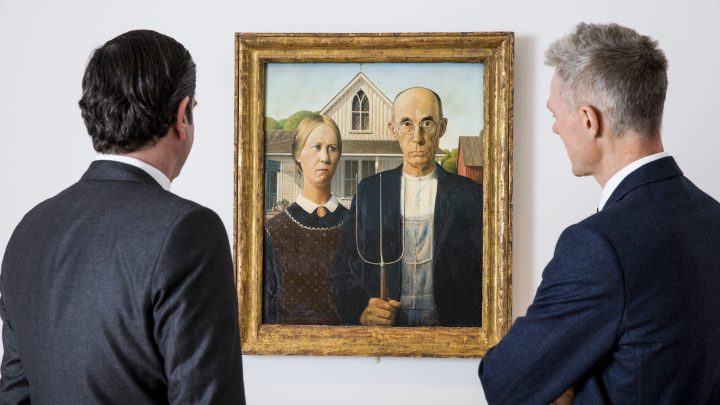
“American Gothic” made this small-town Iowa house a destination
“American Gothic” made this small-town Iowa house a destination

On an unassuming street in Eldon, Iowa — population 785 — a little white house that inspired one of the world’s most famous paintings sits on a grassy lawn.
Built in the 1880s by a local family, the Dibble House, as it’s known in the National Register of Historic Places, features an arched window made famous by the 1930 Grant Wood painting “American Gothic.”

“Grant Wood didn’t even set foot inside the house,” said Cari Nicely, administrator of the American Gothic House Center in Eldon. “That’s not what is significant.”
“It’s the window that has evocative qualities,” said Joni Kinsey, a professor of art history at the University of Iowa. “That window is more akin to something you would see in a small-town church … it’s kind of a third character in the painting.”
The house changed hands at least once before Wood spotted it while he was passing through Eldon on his way to an art exhibition.
“[He] came across this house and said, ‘Stop! Look at that little house with that big pretentious window!’ And he started formulating the idea for ‘American Gothic’ right then and there,” Nicely said.
Wood asked the owner for permission to use the house in a painting, then sat down to sketch.
“He didn’t step foot inside, he never went up to the window. It just was part of that sketch that he created by sitting on the road,” Nicely added.
The painting debuted at the Art Institute of Chicago in 1930, and Wood sold it to the institute that year.
“It was a hit immediately upon its display,” Kinsey said. “But it has escalated in its fame and notoriety in all sorts of ways.”
One of the biggest drivers of the painting’s fame is satire and parody. Versions of “American Gothic” have been plastered on cereal boxes, magazine covers, T-shirts, greeting cards and more.
“When pop art and popular culture became a media focus, the painting started getting reproduced in all kinds of different ways,” Kinsey said. “It just sort of exploded in the 1960s.”
The house was donated to the state historical society in 1991 and rented until 2014, when the last tenant moved out.
The house is vacant now; it’s more useful as a tourist destination. The American Gothic House Center next door has galleries, a gift shop and other exhibits.
“It has a deep meaning to the community,” Nicely said. “Economically it also is important because people come here just to see that house.”
The city’s website features the Dibble House’s window in its logo, proudly christening Eldon “Home of the Gothic House.” The house received about 11,000 visitors last year, according to Nicely, though it regularly welcomed around 16,000 annual visitors before the pandemic.

“We do get a lot of history buffs, we get a lot of artists … we have had visitors here from over 100 countries in the world,” she said. Those visitors often dress up in costumes and pose for photographs in front of the house. Many of them patronize local businesses as well. “The biggest question we get is ‘Where can we eat?’” Nicely said.
“It’s good folksy fun, and yet there’s a lot more value to it than that,” Kinsey said. “That painting is an icon of Iowa.”
“When [Grant Wood] did ‘American Gothic,’ he wanted to paint something that was real,” Nicely said. “That guy that’s in that picture, you could see him up the street or in the store — he’s not a king, she’s not a queen. It’s just down-to-earth people that others could relate to.”
“American Gothic” was painted at the beginning of the Great Depression.

“The one thing that that painting speaks about is a kind of stoic, forthright determination to carry on persevere,” Kinsey said. “That spoke volumes about the resiliency of Americans in that particular time of crisis.”
“This is why people from all over the world come here,” Nicely said. “No matter where you live, you could put your face on there.”
Some visitors leave somewhat negative reviews, noting, “‘It’s just a little house,'” Nicely said. “But I’m hoping that we get people to reach beyond that and understand it’s more than just that little house.”
“It’s a resilience and a solidity — a sense of permanence of American character that it represents in all kinds of ways,” Kinsey said.
Tell us your housing story (or a story about a remarkable house) using the form below, and you may be featured on a future edition of “Adventures in Housing.”
There’s a lot happening in the world. Through it all, Marketplace is here for you.
You rely on Marketplace to break down the world’s events and tell you how it affects you in a fact-based, approachable way. We rely on your financial support to keep making that possible.
Your donation today powers the independent journalism that you rely on. For just $5/month, you can help sustain Marketplace so we can keep reporting on the things that matter to you.


















